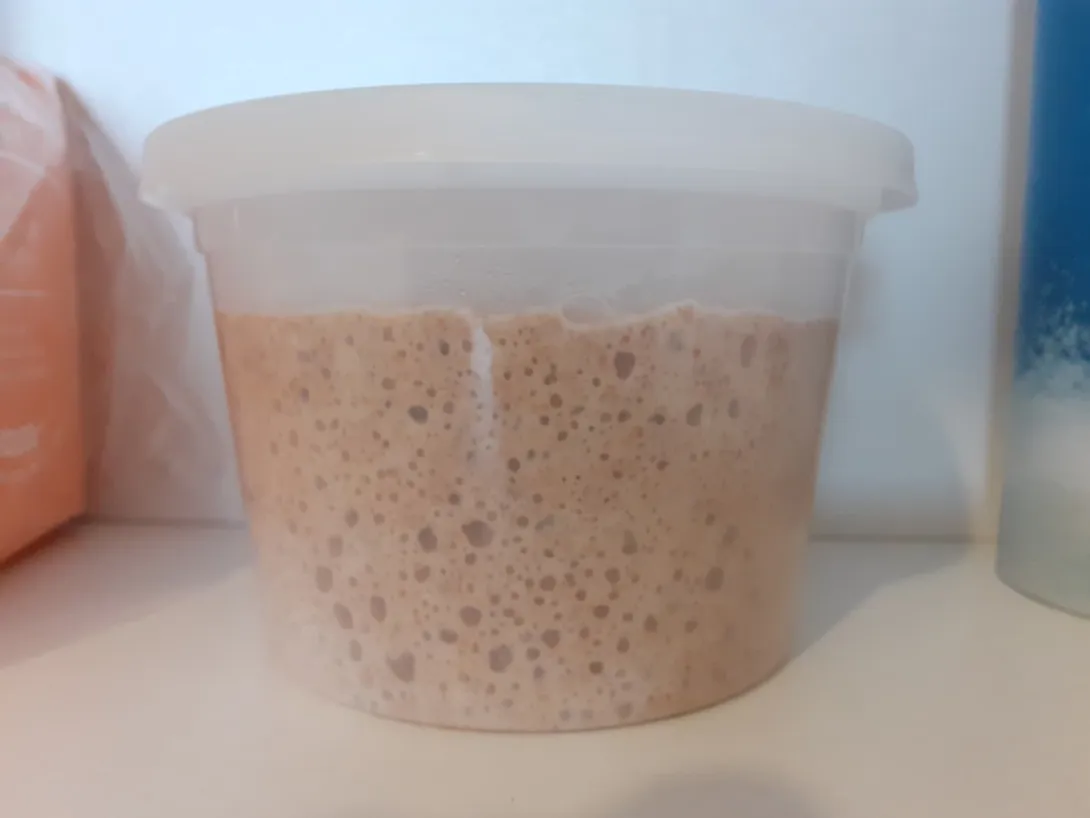
I first heard of this method from Mini Oven. Have tried it once before and it worked a treat. Thought i'd try it again to demonstrate it over on Breadtopia.
Step One: Make a golf ball sized, low hydration, wholegrain dough ball....
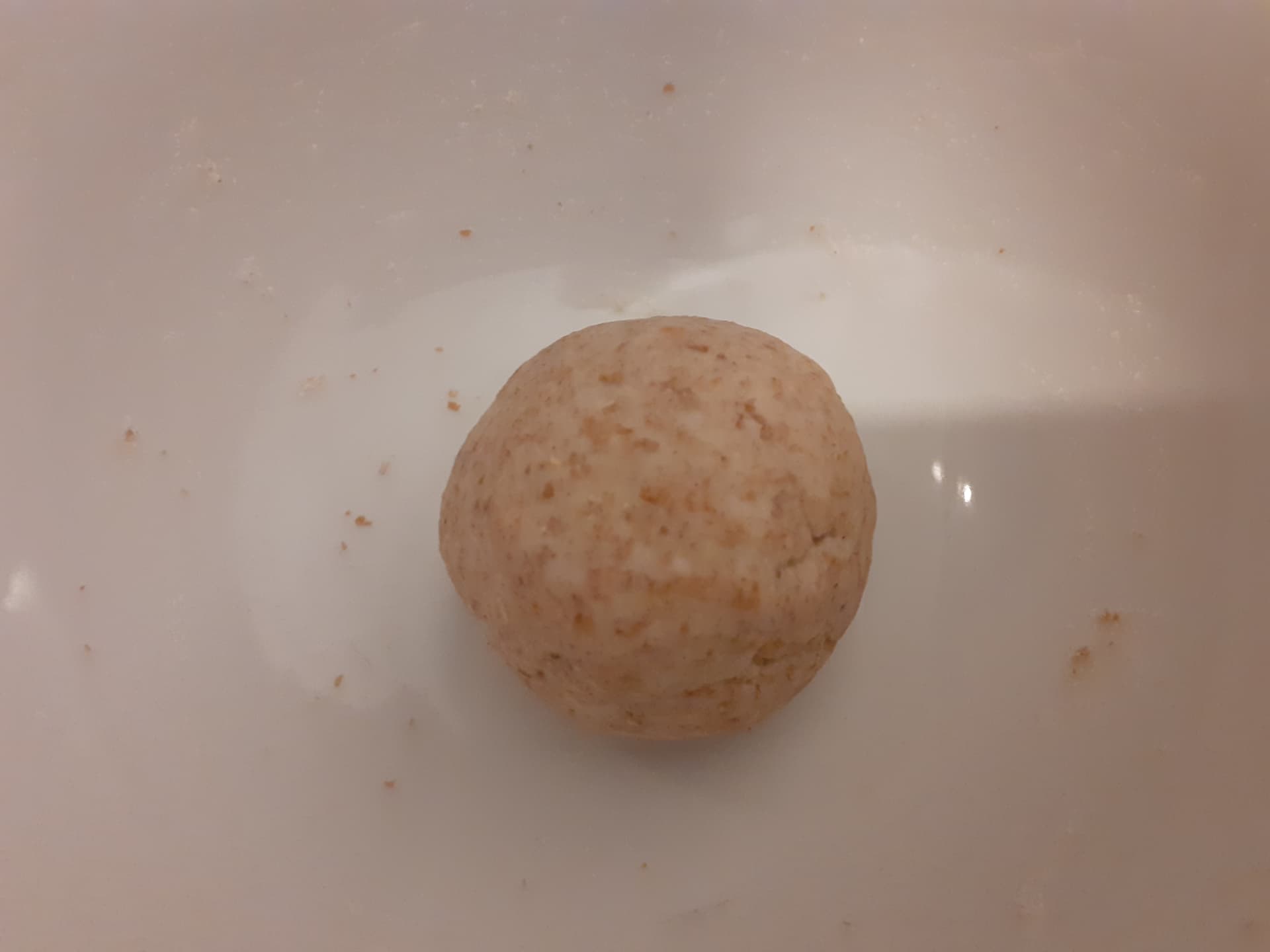
Step Two: Bury it in flour...
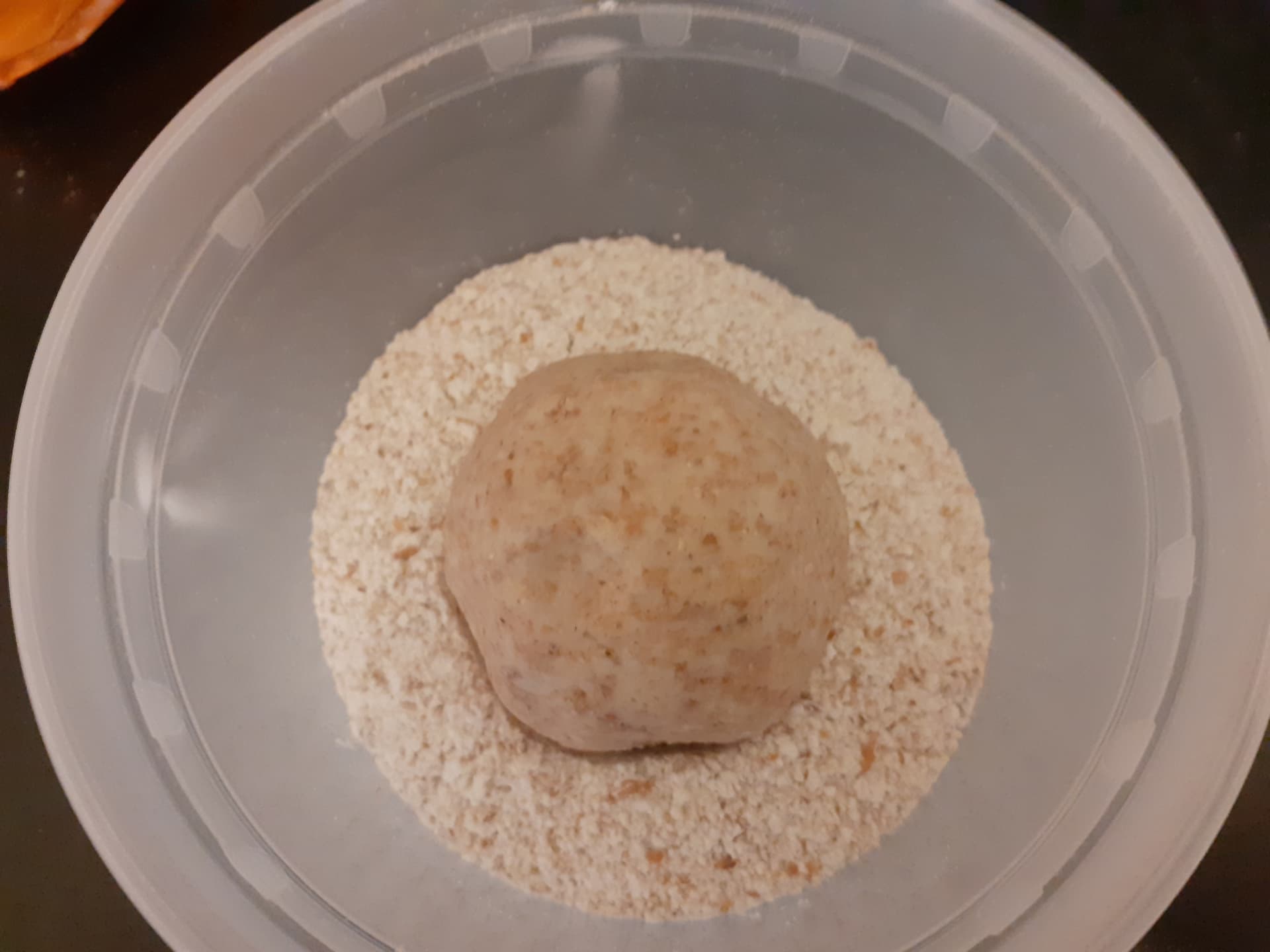
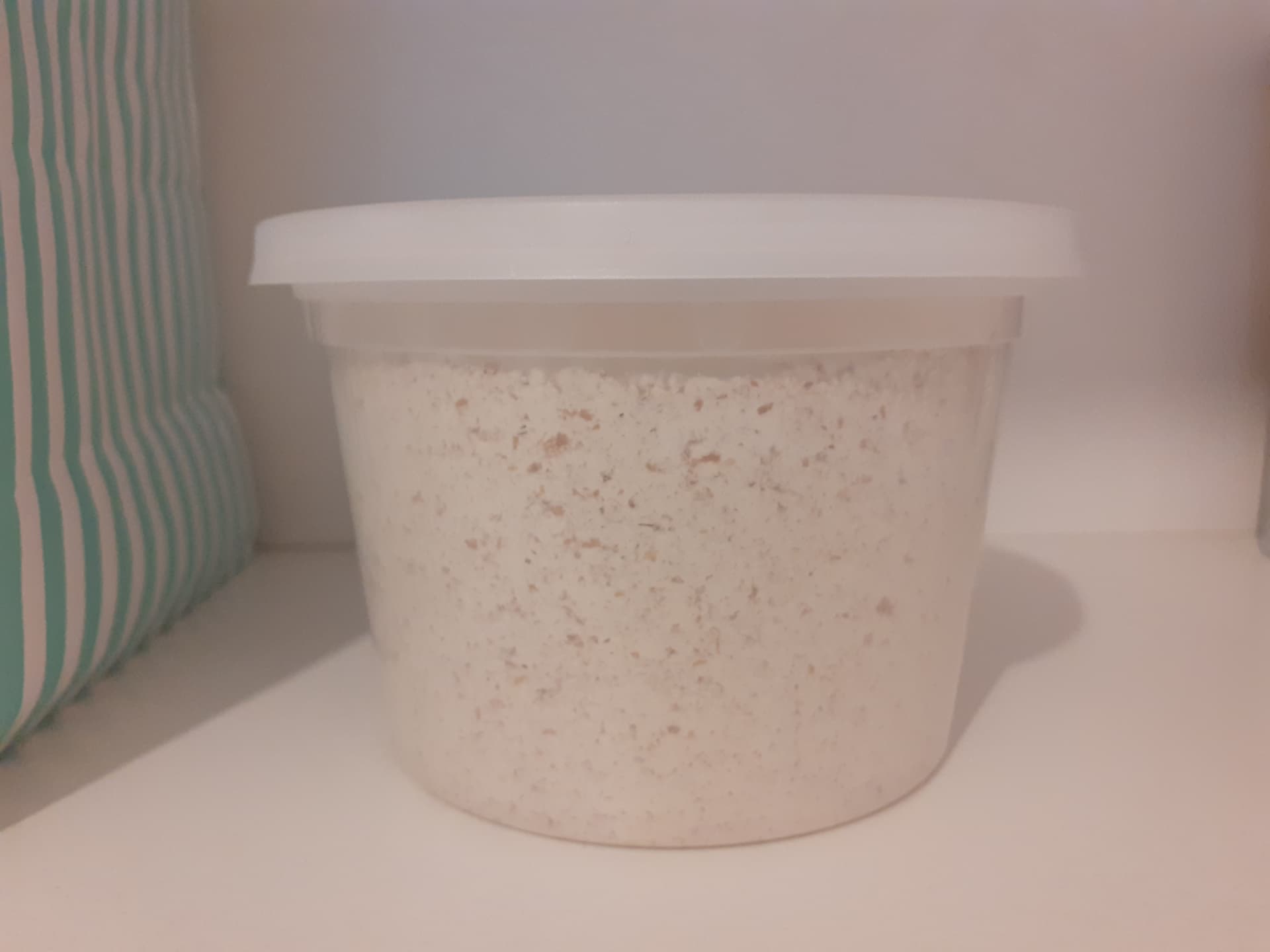
Step Three: Wait a week. Here it is a few days in. "Burst its banks" but left it alone...
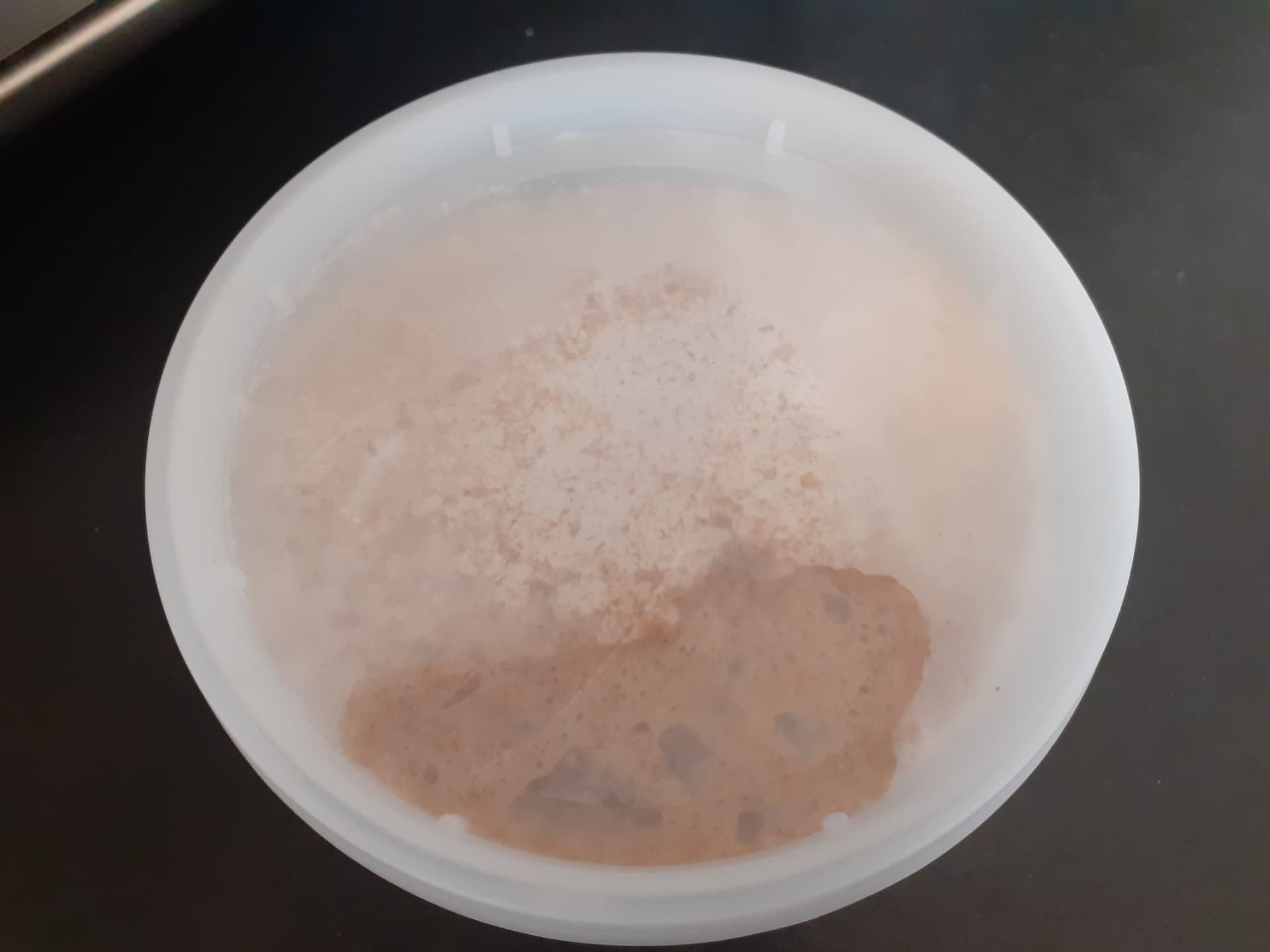
Step Four: After a week cut it open. It should have grown a hard outer shell. Scoop the 'goop' out and feed it. This one split open a bit so the inside had dried out a lot but I pushed on.
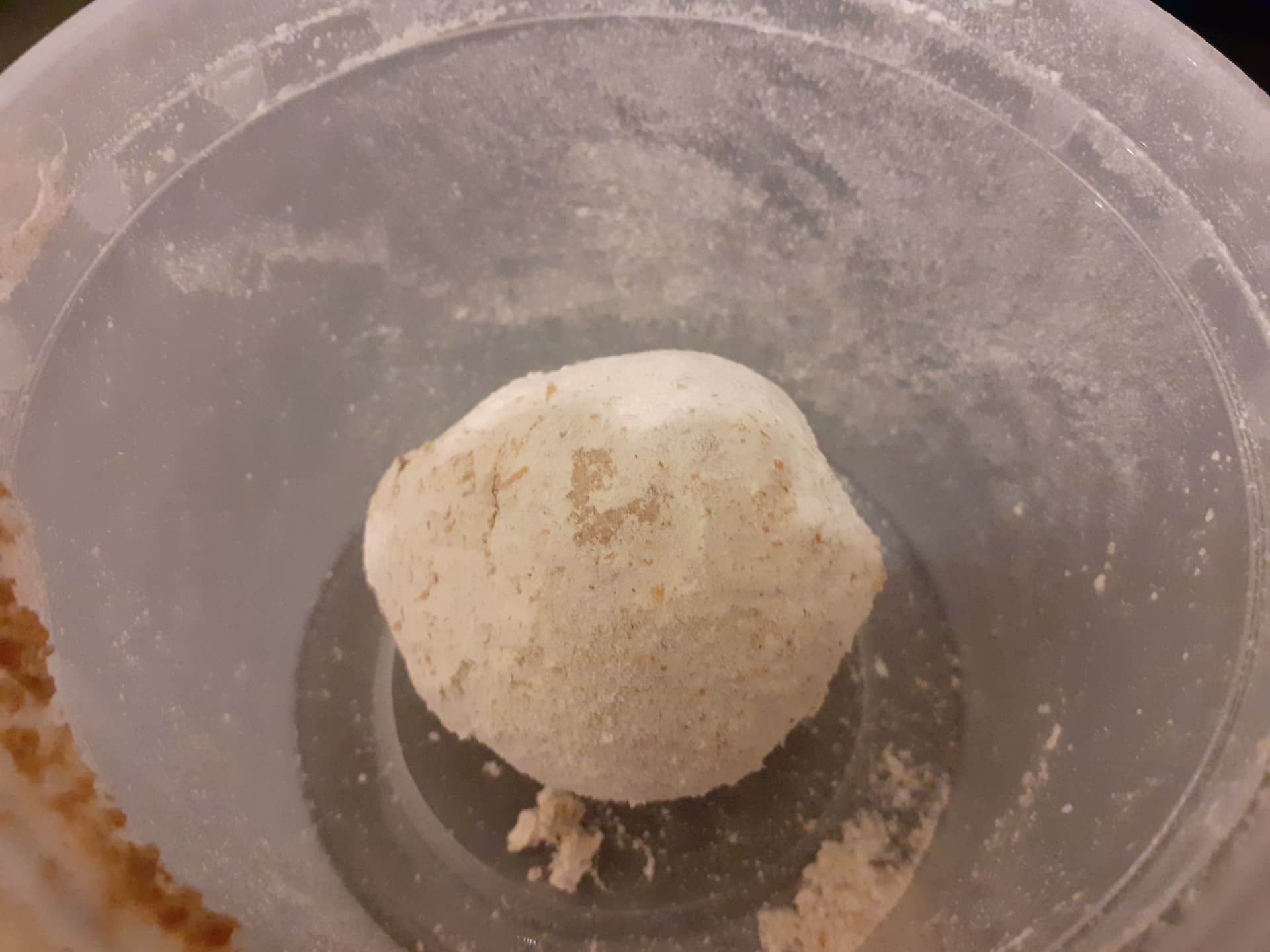
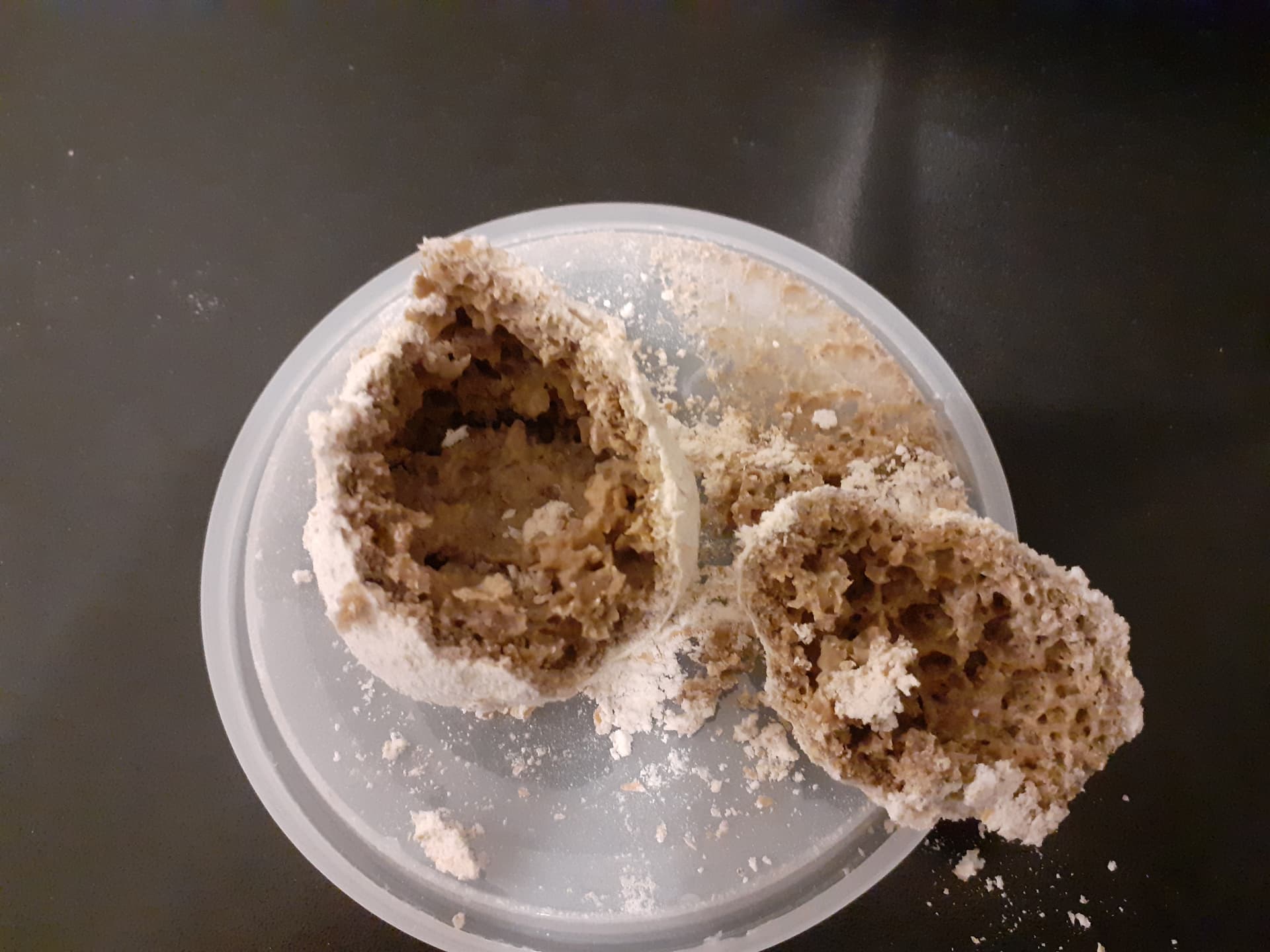
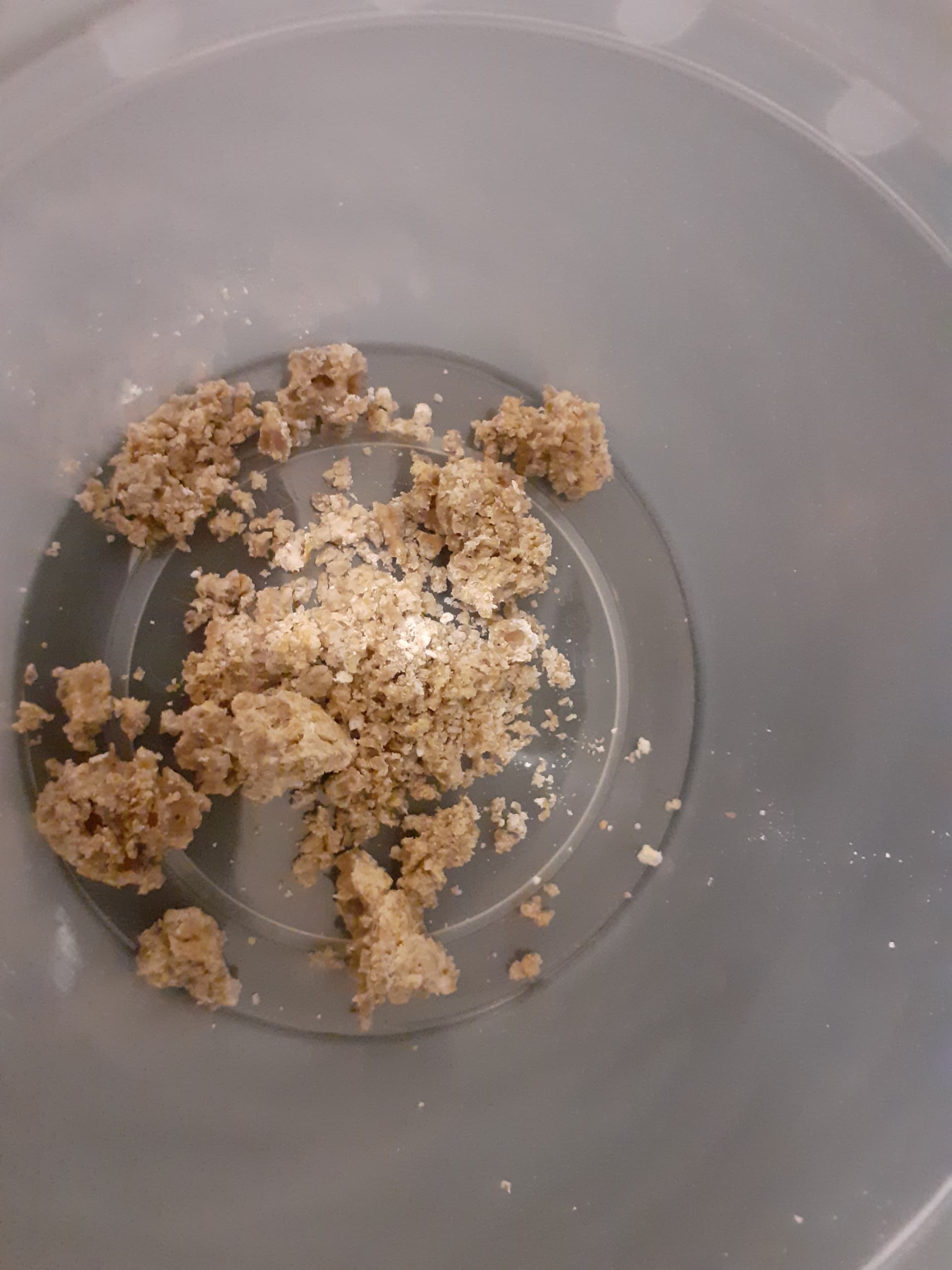
Gave it a very big feed...
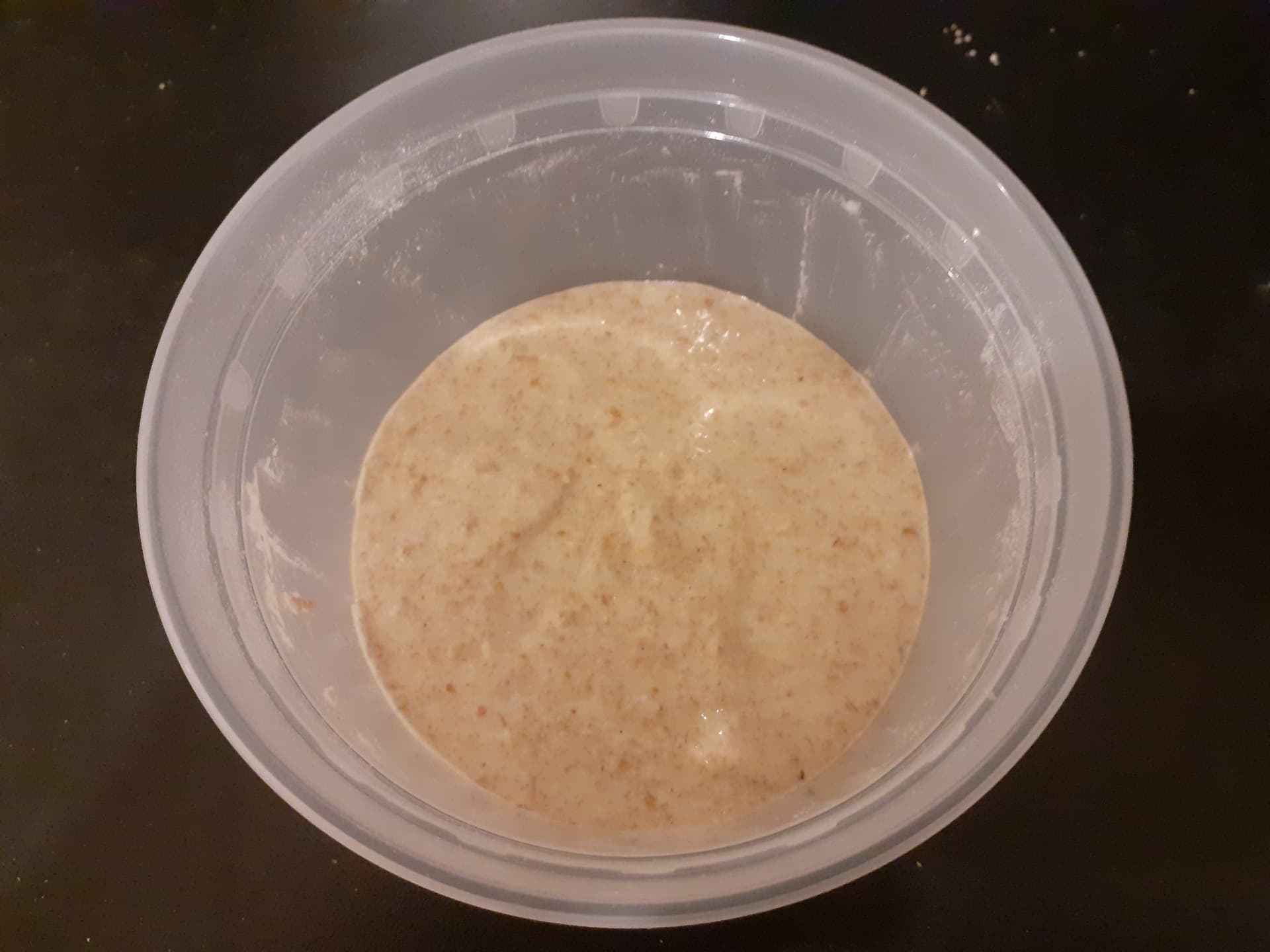
About 15 hours later...
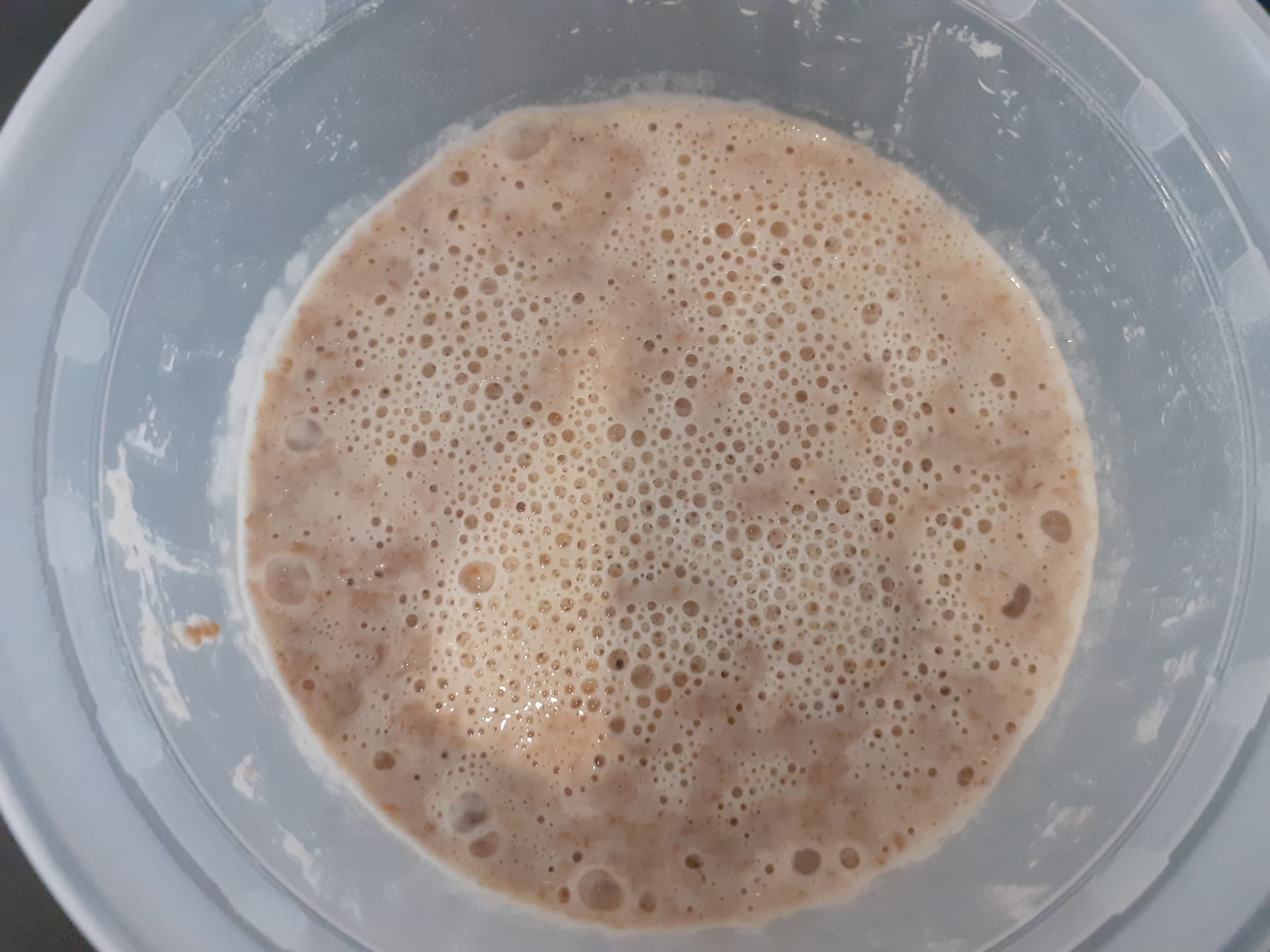
Gave it another big feed and within 12 hours...
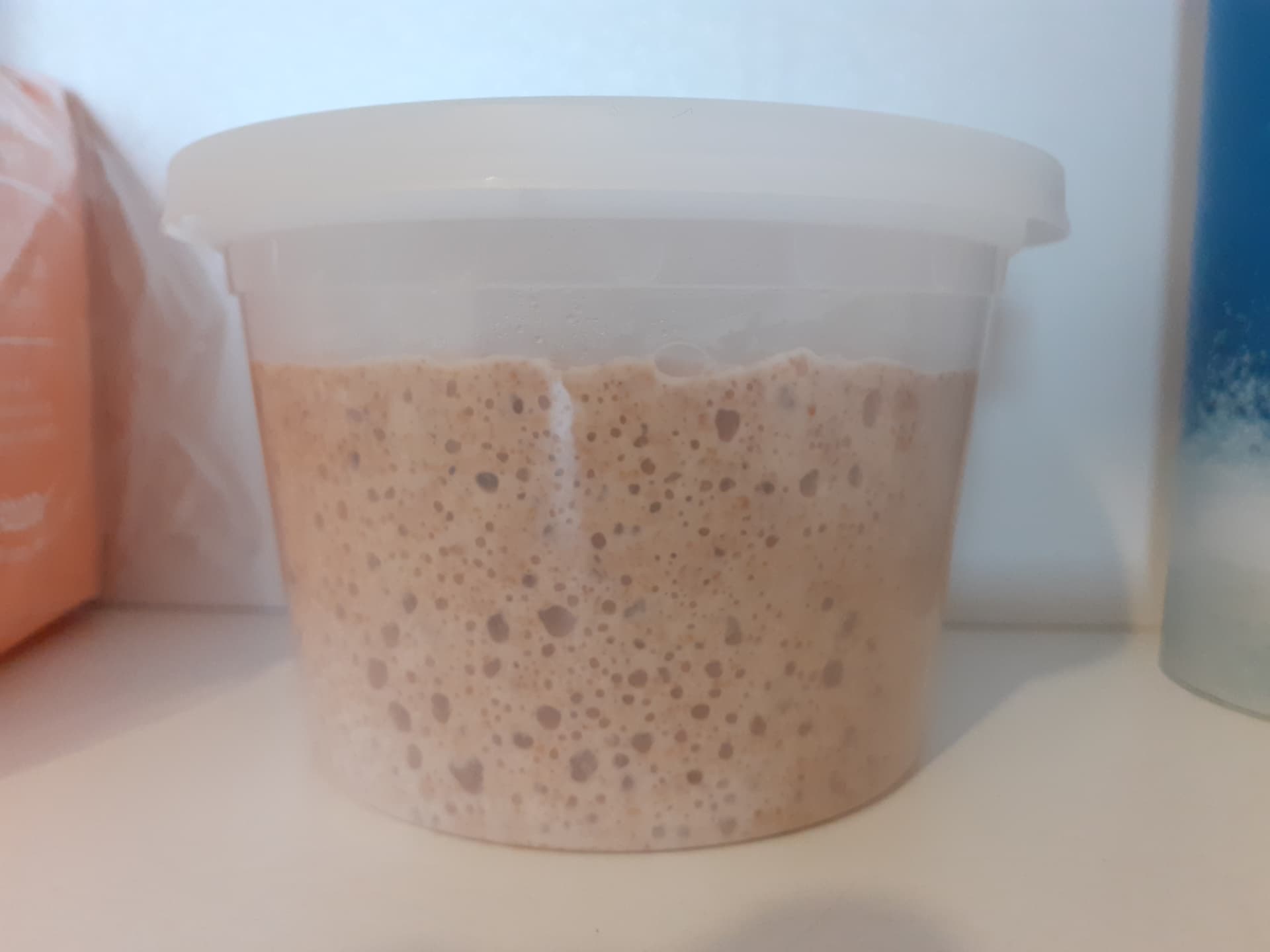
Nothing was measured. Everything eyeballed. Apart from the initial dough ball all it took was two feeds. Otherwise I didn't do anything. I have made starters within a few days being more hands on this took a week and a bit without doing much.
Interesting way.
…and one more confirmation that maybe we might just overthink a lot of breadmaking. Nice one, Abe.
Everyone I have helped make a starter ran into problems because they over thought the process. Feeding extra to wake it up. Or feeding come what may without even looking at the starter to see if it needs feeding etc.
A starter makes it self. We're only there to give it food when it needs it.
Thank you.
I'm with you. Most of the details don't matter. anyone who worries about the exact timing or refreshment ratios is just asking for stress they don't need.
When I make salt-fermented pickles, I make a brine, pack the veggies into the canning jar, pour the brine in, and put the cover on. Then they sit. I burp them once in a while.
Two or three or four weeks later, I've got pickles. Sure, some veggies may take longer depending on their kind, the temperature, and the strength of the brine. But there's no fuss involved *at all*. And BTW, the pickling brine at this point can be used to make a starter in a few days, since it's got lots of lactic acid bacteria and a low pH.
A starter for bread isn't much different.
I think that these details creep into the recipes in two ways. First off, if you want to write something down for beginners to follow, you have to be somewhat specific. Second, there's a lot of superstition out there. Someone makes a starter and thinks that their way is what you have to do. By now, though, we have learned that it probably won't work for everyone. And we have learned that many other ways of making a starter will work.
TomP
With fermentation we set up the optimal parameters and the rest happens with time. You know where people have gone wrong when making a starter when they say they followed a recipe exactly. Perhaps recipes for making starters shouldn't be a list and timings of when to feed but rather what to look for to know when the starter needs feeding and how to judge how much it needs feeding.
That, and as you say, a lot of "well it worked for me this way so it'll work for you".
Never made pickles before. But if it has a lactic acid bacteria ferment then it'll be perfect for kickstarting a starter.
Oh, I don't think so. There are so many variables, it would be difficult and very time consuming to discover an optimum, if one could even define what the optimum is. And then one would have to try varying the ingredients to determine how sensitive this optimum process was to variations in the flour.
And why should we in the amateur bakers' world care about optimums, anyway? We want something that works well enough. We want to know how to troubleshoot.
Might have been better to have said "ideal".
And by superstition, I mean superstition, not just a habit of repeating it because it worked once before.
Rather, true old fashioned superstition, like we had in the "old world".
When it comes to birthing your starter,
"The production of leaven is best undertaken in the middle of a young pine wood because of the pure atmosphere. That will give the best leaven. You begin at dawn, when the dew lays on the ground, the temperature is at its lowest and many bacteria are inactive."
-Jon
So Tom, I make bastardised sauerkraut/kimchi on weekly basis, I had this idea of saving up a tablespoon of juice to be used as starter for the next batch. The spontaneous way usually takes 3 days, certain level of risk getting rotten egg smell, and 2% minimum of salt. Using 'starter', only takes a night, zero risk of rotten egg smell, and 1% of salt usage 😆 (I suspect I can do it salt free)
Jay
That would work but you can use the brine instead of all the water for making the new starter. You don't need to add salt because the brine is plenty salty already. Although if you use a high concentration of salt, maybe that would be too much and you shouldn't use 100% brine. (Actually, I never have used salt when making a new starter).
I pickled some sweet corn kernels and after they were ready I kept the jar in the fridge, even after there were only a few kernels left. A year after starting the pickling I used that brine to make a new starter. It was ready to use after two days. Yours seem to develop faster (is your kitchen rather warm?), so maybe it would go even faster with the brine.
The way I see things, the pH of the new starter has to drop down low enough, near 4.0, before dormant yeast will wake up and start to multiply. Using an acidic liquid lets you start close to that goal, and has the benefit of being too acidic to support those bad-smelling bacteria. Vinegar is apparently not a good choice, but pickling brine, pineapple juice, other acidic fruit juices, and even yogurt whey can do the job. The brine also starts out with plenty of lactic acid bacteria, which are going to finish the job of acidifying your mix faster than starting out with water could.
nope, no added water. Water dilutes flavor. I do salt-and-massage method. I don't keep dedicated kimchi starter, just saving up a tablespoon of juice. Been doing that for months. Flavor and aroma always consistent, and low fermenting salt allows me to put more fish sauce and oyster sauce
Jay
Oh, of course, I should have realized. A different style of pickle. So yes, even less of the juice should help move things along.
Can you give me more information? How much veggies, water, salt? Everything I have read about pickling seems too complicated. Thank you.
Salt-fermented pickles are very easy. Make up a 2%-3% brine. Cut your veggies - it's easiest to start with pickling cucumbers or radishes - or leave them whole if they are shaped and sized right. **
Pack them into a cleaned jar such as a Ball jar or other canning jar. It should be clean but doesn't need to be sterilized. Fill up the jar with the brine and leave a little headroom at the top to allow for expansion and a space for gasses to collect.++
Close the top. It doesn't have to completely seal (CO2 will have to escape) but even if it is, you can just open the lid enough to break the seal every day or few days to let the gasses out. You are likely to get a little liquid oozing out so put the jars on something to collect or absorb it.
In two weeks or so you will have pickles and the pickling liquid, filled with lactic acid bacteria. That's what I used to make a sourdough starter. Actually, mine was a year old. I had eaten the pickles and kept the leftover juice in the refrigerator.
** Veggies should be clean and in good condition but don't wash them too hard since you need to let some the the lactic acid bacteria remain. Don't cook or boil them since that would kill off the desired bacteria.
++ The veggies may rise to expose their tops to the airspace. It's better to keep them submerged. You can put a flat rock in them, or a small plastic bag with some air in it, just under the lid, to keep the veggie tops down.
As the pickling progresses the brine will become more acidic. At each stage of acidity, different organisms will grow best (and may or may not give off much gas) but after several days or a week the acidity will be too low for anything else besides the lactic acid to flourish. This progression is exactly like the progression of a new sourdough starter.
That method really reminds of the old-fashioned way of making Desem starter :)
I assume in that case you'd give a lot more wiggle room regarding the temperature, as opposed to conventional Desem
Jay
I haven't delved too much into Desem Starters. I do know the method for maintaining a starter is similar. Low hydration and buried in flour. This is to bring out certain characteristics wanted from this type of starter. Although i've never seen how a Desem starter is made initially. I believe one can turn any starter into a Desem by making it low hydration and maintaining this way. So is there a special way making one from scratch?
Yes, buried in flour would make it more insulated and temperature might not be as much of an issue.
Have a try, Jay. It's a fun process.
I've captured the essence of Desem, without doing the conventional Desem. The idea was making sweet starter, but with whole grain, and fridge temperature maintenance. Cariah Marey could be left overnight and producing literally sweet bread. Even 3 grams of her for 1kg of flour, not sour at all, and literally sweet.
I have put a lot of 'ankle weight' on her. She is osmotolerant and tolerant to freezing, and on her way to build tolerance toward butter. And she proofs craaaazy fast. My final rise for baguettes only lasts less than an hour nowadays! 😆
I agree that some starter making methods are too overcomplicated. I like to experiment with feeding flours, what I usually do is just feed with new flour, and leave it in fridge for a week or two. If it smells floral and alcoholic, it's done.
I'd love to share my method, it's just I'm not sure whether it's what I did from point Y to point Z, or from point A to point Z.
Jay
Hey Jay,
Been meaning to ask you about [Cariah] maintenance, actually, so do you just feed:
1:1:1:1 bran:skim milk:water:butter
(your new ratio?)
No sugar or flour?
Any special things you do (e.g. keep in fridge only after rising or no fridge at all)?
-Jon
Regarding the starter - if it works - great. Seems like a PITA - but if it works who can argue. Enjoy!
You literally don't have to do anything. Takes few minutes to prepare and then you just wait a week.
I used the same approach to travel with my starter. I partway filled up a small container with flour, dropped a glob of starter in, and covered it with more flour. I kept it in an ice chest in the car along with food for the trip.
Doesn't matter how it's made - a week is not long enough. Not for me anyway. It takes longer - 3 if all goes well - and it's a starter. Enjoy!
Within 4 - 5 days.
If you want to use it - go right ahead. I'll wait. Enjoy!
Less is more! For years since 2010 and my first cross-country cycling trip I have made a very solid dough ball out of my stored starter and just set it in the back of the fridge.
I did the same when I went away all of March. Bennie did as well. My starter has been gung ho after this trip and after all the others.
It loves being rehydrated and I’ve never measured I just go by how it feels . It triples in a few hours. I’m quite tempted to start keeping it very solid all the time and just pinch off some to create a levain . When I’ve used most of the stored just make more solid dough out of it. I used to do this and don’t know why I stopped .
Glad you posted Abe and Tom ! c
and it seems to work very well. I'd say after a week it's just 2 to 3 feeds away to bake bread. It seems to be very yeasty as it rises very fast. For the two feeds I used a very small starter : fresh feed ratio and it bubbled up in good time. Smells a tad funky when first cutting open but not too bad. And it soon goes away. You might like a Desem starter.
Thank you Caroline.
Bakers are covered with sourdough critters on our skin and our gear. Researchers at NC State sequenced the microorganisms on the hands of bakers at an international conference and found they had LAB and yeast on their hands that matched their SD starters.
I wonder how much of the gap between the difficulty of creating a starter by beginners and the ease by experienced bakers is the result of accidental contamination?
Gary
I think there's a lot of truth in this, and it may not always come from the skin and clothes of the baker. I read about a highly experienced baker from the West Coast (of the US) who came East to compete in a baking competition. He didn't bring any of his equipment with him. He couldn't get a new starter going. He concluded that the problem was that he didn't have his old wooden bowl he always used; instead, he was supplied with new stainless ones. Presumably the old bowl had a lot of sourdough organisms trapped in the pores and crevices. (I think this story is told in Peter Reinhart's The Bread Baker’s Apprentice, but my copy isn't available to check).
New flour and a new container. And it wasn't even fed for a week.
I'm positive that most people run into problems when it comes the feeding schedule. Discarding and feeding too often which interrupts the fermentation process.
Lovely descriptions and photos.
It sure looks like the desem method, with a few minor differences, namely the initial ball for desem is made from pulped whole grain berries rather than whole wheat flour and there is an emphasis on keeping it at around
15-17°Cummm 10-18°C for that first week. My current starter was born that way!Did you get that fabled smell of apples (is it malic acid?), associated with Desem?
-Jon
This is Mariana's description of starting a Desem (Omar Gevaert's method).
I didn't feed it for a week but now when I feed I get a very strong aroma of Yoghurt.
I'm going to look into how to maintain a desem starter.
There is a difference between making and storing a starter. You'll get it. Enjoy!
I have a cookbook and recipe guide from the early 1800s for the "homemaker" of the day. It describes something very similar as the "standard" way to make a week's worth of bread. I never gave it much thought till now. I guess I should have.